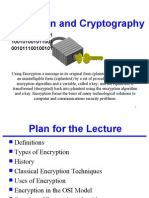0% found this document useful (0 votes)
94 views11 pagesCryptography
Cryptography is the process of converting data into a secret code to allow for secure transmission over public networks. It involves encrypting plaintext using an algorithm and key into ciphertext, which is decrypted at the receiving end. There are different types of encryption algorithms that use either symmetric secret keys, where one key encrypts and decrypts, or asymmetric public key cryptography, where different keys encrypt and decrypt. Cryptography ensures encryption of data for privacy, integrity to prevent tampering, identification of senders, and authentication of parties involved in communication.
Uploaded by
Mahak AhujaCopyright
© © All Rights Reserved
We take content rights seriously. If you suspect this is your content, claim it here.
Available Formats
Download as PPTX, PDF, TXT or read online on Scribd
0% found this document useful (0 votes)
94 views11 pagesCryptography
Cryptography is the process of converting data into a secret code to allow for secure transmission over public networks. It involves encrypting plaintext using an algorithm and key into ciphertext, which is decrypted at the receiving end. There are different types of encryption algorithms that use either symmetric secret keys, where one key encrypts and decrypts, or asymmetric public key cryptography, where different keys encrypt and decrypt. Cryptography ensures encryption of data for privacy, integrity to prevent tampering, identification of senders, and authentication of parties involved in communication.
Uploaded by
Mahak AhujaCopyright
© © All Rights Reserved
We take content rights seriously. If you suspect this is your content, claim it here.
Available Formats
Download as PPTX, PDF, TXT or read online on Scribd
/ 11





























































